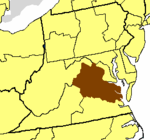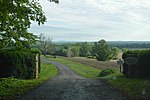Graffiti House
American Civil War museums in VirginiaBarbour family residencesHouses completed in 1858Houses in Culpeper County, VirginiaHouses on the National Register of Historic Places in Virginia ... and 3 more
Military and war museums in VirginiaMuseums in Culpeper County, VirginiaNational Register of Historic Places in Culpeper County, Virginia

The Graffiti House, located at 19484 Brandy Road in the eastern end of the town of Brandy Station, Virginia, is believed by the Brandy Station Foundation to have been built in 1858. It is one of few dwellings in the village built before the American Civil War to survive intact to this day. The house is notable because of the Civil War era graffiti on many of the walls. The graffiti found includes names, drawings, names of units, and inscriptions left by soldiers.
Excerpt from the Wikipedia article Graffiti House (License: CC BY-SA 3.0, Authors, Images).Graffiti House
Fleetwood Heights Road,
Geographical coordinates (GPS) Address Nearby Places Show on map
Geographical coordinates (GPS)
| Latitude | Longitude |
|---|---|
| N 38.504166666667 ° | E -77.890833333333 ° |
Address
Fleetwood Heights Road 19777
22714
Virginia, United States
Open on Google Maps










